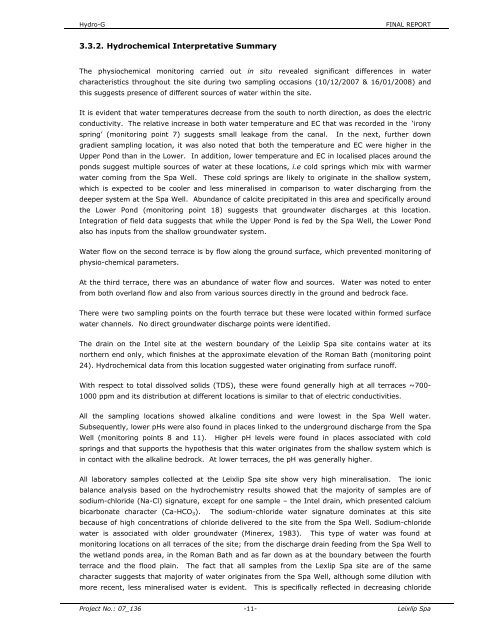Hydro G Final report - Kildare.ie
Hydro G Final report - Kildare.ie
Hydro G Final report - Kildare.ie
Create successful ePaper yourself
Turn your PDF publications into a flip-book with our unique Google optimized e-Paper software.
<strong>Hydro</strong>-G FINAL REPORT<br />
3.3.2. <strong>Hydro</strong>chemical Interpretative Summary<br />
The physiochemical monitoring carr<strong>ie</strong>d out in situ revealed significant differences in water<br />
characteristics throughout the site during two sampling occasions (10/12/2007 & 16/01/2008) and<br />
this suggests presence of different sources of water within the site.<br />
It is evident that water temperatures decrease from the south to north direction, as does the electric<br />
conductivity. The relative increase in both water temperature and EC that was recorded in the ‘irony<br />
spring’ (monitoring point 7) suggests small leakage from the canal. In the next, further down<br />
grad<strong>ie</strong>nt sampling location, it was also noted that both the temperature and EC were higher in the<br />
Upper Pond than in the Lower. In addition, lower temperature and EC in localised places around the<br />
ponds suggest multiple sources of water at these locations, i.e cold springs which mix with warmer<br />
water coming from the Spa Well. These cold springs are likely to originate in the shallow system,<br />
which is expected to be cooler and less mineralised in comparison to water discharging from the<br />
deeper system at the Spa Well. Abundance of calcite precipitated in this area and specifically around<br />
the Lower Pond (monitoring point 18) suggests that groundwater discharges at this location.<br />
Integration of f<strong>ie</strong>ld data suggests that while the Upper Pond is fed by the Spa Well, the Lower Pond<br />
also has inputs from the shallow groundwater system.<br />
Water flow on the second terrace is by flow along the ground surface, which prevented monitoring of<br />
physio-chemical parameters.<br />
At the third terrace, there was an abundance of water flow and sources. Water was noted to enter<br />
from both overland flow and also from various sources directly in the ground and bedrock face.<br />
There were two sampling points on the fourth terrace but these were located within formed surface<br />
water channels. No direct groundwater discharge points were identif<strong>ie</strong>d.<br />
The drain on the Intel site at the western boundary of the Leixlip Spa site contains water at its<br />
northern end only, which finishes at the approximate elevation of the Roman Bath (monitoring point<br />
24). <strong>Hydro</strong>chemical data from this location suggested water originating from surface runoff.<br />
With respect to total dissolved solids (TDS), these were found generally high at all terraces ~700-<br />
1000 ppm and its distribution at different locations is similar to that of electric conductivit<strong>ie</strong>s.<br />
All the sampling locations showed alkaline conditions and were lowest in the Spa Well water.<br />
Subsequently, lower pHs were also found in places linked to the underground discharge from the Spa<br />
Well (monitoring points 8 and 11). Higher pH levels were found in places associated with cold<br />
springs and that supports the hypothesis that this water originates from the shallow system which is<br />
in contact with the alkaline bedrock. At lower terraces, the pH was generally higher.<br />
All laboratory samples collected at the Leixlip Spa site show very high mineralisation. The ionic<br />
balance analysis based on the hydrochemistry results showed that the majority of samples are of<br />
sodium-chloride (Na-Cl) signature, except for one sample – the Intel drain, which presented calcium<br />
bicarbonate character (Ca-HCO3). The sodium-chloride water signature dominates at this site<br />
because of high concentrations of chloride delivered to the site from the Spa Well. Sodium-chloride<br />
water is associated with older groundwater (Minerex, 1983). This type of water was found at<br />
monitoring locations on all terraces of the site; from the discharge drain feeding from the Spa Well to<br />
the wetland ponds area, in the Roman Bath and as far down as at the boundary between the fourth<br />
terrace and the flood plain. The fact that all samples from the Lexlip Spa site are of the same<br />
character suggests that majority of water originates from the Spa Well, although some dilution with<br />
more recent, less mineralised water is evident. This is specifically reflected in decreasing chloride<br />
Project No.: 07_136 -11-<br />
Leixlip Spa
















